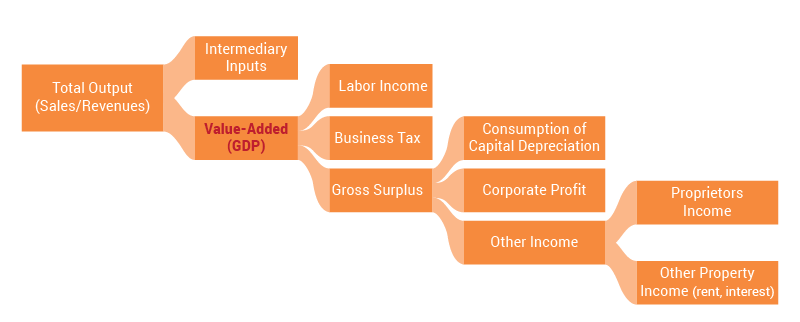Gross Domestic Product (GDP) is one of the most widely used and cited economic indicators. One cannot discuss the economy of a country or a region without talking about the national or regional GDP. However, many often misunderstand GDP. Specially, some may confuse GDP with the value of the total output (revenue) of an economy.
The reason GDP is misunderstood can be traced to its intended use. The origin of GDP is the need for an economic indicator to measure the overall size of a national or regional economy, so that people can compare which country has the largest or second largest economy in the world. When we think of a business such as a retail shop or a manufacturing plant, we typically use their total sales or revenue as an indicator of the size of their business. For example, Fortune magazine routinely publishes America’s 500 largest companies based on their total revenue. Similarly, when we need a measure of the size of a national or regional economy, it is natural for people to think of this measure as the sum of the revenue (output) of all businesses in a country or region.
While that thinking has its merit, total output (revenue) it is not a good indicator of a true size of the national or regional economy because it allows the possibility of double counting, which could inflate the size of an economy. Consider a business, which buys cotton from famers, and make shirts for the consumer. It has two plants—one turns cotton into fabric, and the other plant has sewing machines to stitch fabrics into shirts. Each shirt sells for $50 dollars. If the business makes only one shirt, the total revenue for the company is $50.
What if the owner decides to split the two plants into two separate businesses: one produces fabric and the other purchases the fabric and produces shirts? If the price of the fabric is $20, the total revenue of those two separate companies are $70, while the total sale of the company prior to split is $50. Even though only one shirt is produced in the process, the total output jumps from $50 to $70. One would think the economy represented by two companies is larger, even though only one shirt is produced. The difference is that the value of the fabric is included in both the revenue of the fabric and shirt companies. This example shows that summing up total output (revenue) of all businesses in a country or region is not a good measure of the true size of the economy due to the fact that the value of the intermediary goods (in this case the fabric) is counted twice or multiple times.
Thus, the concept of GDP was born. GDP is the sum of all companies’ total sales minus the value of the intermediary inputs. The difference between the total sales and the intermediary input is also defined as the value added of a business. Another commonly used definition of GDP is that it is the sum of consumer expenditures, business investment, government spending, and net exports. This definition is equivalent to the total value added of a country or region, because this definition counts only the value of final products and services; and not the value of intermediary products.
What types of values are added to the intermediary inputs and turned into another product? As the following diagram shows, the main components of value added are the labor income, business tax, and gross surplus. In addition, gross surplus is made up of the consumption of capital (or depreciation), corporate profits, and other income such as rents, interest, and proprietors’ income.
In 2014, U.S. GDP (or value added) was 54% of the total output of the country. Within GDP, more than half (53%) of it is labor income, with the rest making up gross surplus and business tax.
.png)
